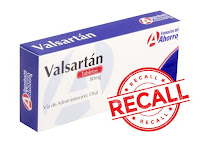Florida DCF is Corrupt with Marc Miller http://tobtr.com/s/11396595
https://livertox.nlm.nih.gov/Valsartan.htm
OVERVIEW
Valsartan
Valsartan
Introduction
Valsartan is an angiotensin II receptor blocker used alone or in combination with other agents to treat hypertension and reduce cardiovascular mortality after myocardial infarction. Valsartan is associated with a low rate of transient serum aminotransferase elevations and has been linked to rare instances of acute liver injury.
Background
Valsartan (val sar' tan) was the second angiotensin II receptor blocker (ARB) to be approved for use in the United States and is widely used for therapy of hypertension. Valsartan inhibits the renin-angiotensin system by blocking the angiotensin II type 1 receptor (AT1), which prevents the vasoconstriction and volume expansion induced by circulating angiotensin II which accounts for its antihypertensive activity. Valsartan was approved for use in the United States for hypertension in 1996 and indications were subsequently broaded to the treatment of heart failure and for reduction in cardiovascular mortality in patients with left ventricular dysfunction after myocardial infarction. Valsartan is available in 40, 80, 160 and 320 mg tablets generically and under the trade name Diovan. The typical initial dose of valsartan in adults in 80 to 160 mg once daily, and it is used long term. Valsartan is also available in fixed combinations with hydrochlorothiazide (Diovan-HCT), amlodipine (Exforge and Exforge HCT) and aliskiren (Valturna). Side effects of valsartan are uncommon, but can include headache, dizziness, fatigue, cough, gastrointestinal upset, and fetal toxicity. In addition, many ARBs including valsartan have been linked to cases of severe sprue-like enteropathy. The enteropathy arises after months or years of therapy and presents with severe diarrhea, weight loss, abdominal discomfort and fatigue. Intestinal biopsy shows villous flattening and atrophy similar to celiac disease. However, the enteropathy does not improve with a gluten-free diet but does resolve with stopping the angiotensin receptor blocker.
Hepatotoxicity
Valsartan has been associated with a low rate of serum aminotransferase elevations (<2%) that in controlled trials was no higher than with placebo therapy. These elevations were transient and rarely required dose modification. Rare instances of clinically apparent acute liver injury have been reported in association with valsartan therapy. The onset is usually within 1 to 8 weeks of starting therapy and the serum enzyme pattern is typically hepatocellular with an acute hepatitis-like clinical syndrome. In some instances, cholestasis has developed which can be prolonged and relapsing, but valsartan therapy has not been associated with vanishing bile duct syndrome or chronic liver injury. Immunoallergic manifestations (rash, fever, eosinophilia) are not common, nor is autoantibody formation. In addition, serum aminotransferase elevations can accompany the enteropathy associated with ARB therapy, probably as a result of fatty liver disease and steatohepatitis due to the diarrhea and malnutrition.
Likelihood score: D (Possible rare cause of clinically apparent liver injury).
Mechanism of Injury
The cause of the liver injury that has been associated with valsartan is not known, but it resembles idiosyncratic liver injury due to a hypersensitivity reaction. Valsartan does not appear to be metabolized by the cytochrome P450 system to a major degree.
Outcome and Management
The instances of acute liver injury reported with valsartan use have been self limited and have not resulted in acute liver failure or chronic liver injury. While corticosteroids have been used in cases of severe cholestasis due to ARBs, their efficacy has not been shown and their use is best avoided. Patients with valsartan induced acute liver injury should probably avoid use of other ARBs, although cross sensitivity to liver injury among the members of this class of agents has not been shown.
References on the safety and potential hepatotoxicity of valsartan are given in the Overview section on the Angiotensin II Receptor Antagonists.
Drug Class: Antihypertensive Agents, Angiotensin II Receptor Antagonists
Other Drugs in the Subclass, Angiotensin II Receptor Antagonists: Azilsartan, Candesartan, Eprosartan, Irbesartan, Losartan, Olmesartan, Telmisartan
Top of page
REPRESENTATIVE TRADE NAMESValsartan – Diovan®
DRUG CLASSAngiotensin II Receptor Antagonists
COMPLETE LABELING
Product labeling at DailyMed, National Library of Medicine, NIH
Top of page
CHEMICAL FORMULA AND STRUCTURE
Valsartan
Valsartan
| DRUG | CAS REGISTRY NUMBER | MOLECULAR FORMULA | STRUCTURE |
|---|---|---|---|
| Valsartan | 137862-53-4 | C24-H29-N5-O3 |  |








No comments:
Post a Comment
Note: Only a member of this blog may post a comment.